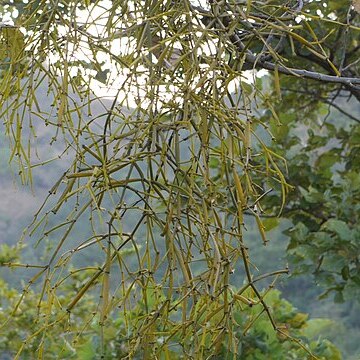Pendulous slender plant to 1 m long. Internodes compressed-quandrangular with acute marginal and median ridges, 2–4.5 cm long, usually 1.5–2.5 mm wide, the basal ones becoming terete with age. Leaves reduced to a limb c. 0.5 mm high subtending inflorescences. Inflorescence of several sessile axillary flowers developing successively; first flower usually female and solitary; male flowers usually in a pair below involucre of female, subtended by acute bracts c. 0.7 mm long; subsequent flowers mostly female, developing below earlier ones. Male flower pyramidal, 1 mm long. Female flower broadly cylindrical; ovary c. 0.5 mm long; tepals c. 0.5 mm long. Fruit globular, 4–6 mm diam., somewhat translucent, white, pale yellow or pink.
Shrubs which climb and feed on other plants. They are vines which hang down. The vines are square in cross section but become round with age. They have ridges along them. The leaves are reduced to small scales near the flowers. Several flowers develop one after another along the flowering shoots. The male and female flowers are separate but on the same plant. The male flowers are triangular shaped while the female flowers are more like cylinders. Male flowers are near the edge and female flowers at the centre. The fruit is a white or yellow berry which lets light through. The fruit are round, smooth and 3-4 mm across. The fruit is attached to a long sticky strand.
Plant slender, pendulous. Stem internodes at maturity decussately flattened or compressed, quadrangular or double-edged with a raised angular rib on each face, 15-50 mm long, 0.5-3 mm wide below, widened to 1-5 mm above. Leaves rudimentary, spreading, c. 0.5 mm long. Inflorescence axillary, a sessile cymule of 1 flower subtended by a cupule c. 1 mm long, with subsidiary cymules developing lateral to the first one, with the first-formed flower female and the lateral flowers female or male. Fruit globose, sessile, smooth, white. Fig. 9a. Fig. 10.

